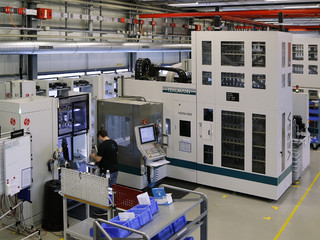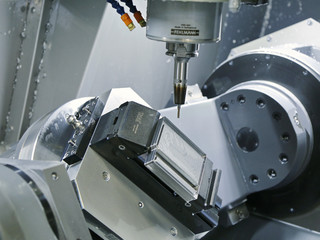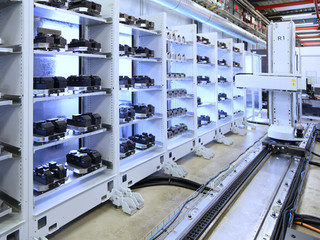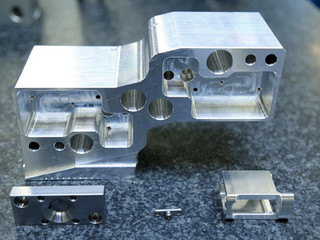In-house production made possible with flexible production islands
Swiss-Made: Manufacturing technology project of the future
Rychiger AG invested in the future of production technology with a self-sufficient production island. A network of two Fehlmann Versa 825 with workpiece and tool storage, an integrated measuring machine and a washing system ensures low-manpower production of very small series. Hard milling and grinding processes are part of the manufacturing solution. Rychiger AG is re-orienting its parts production strategy with this machining cell - supplying spare parts and key components, while developing new components that possess the required technological competence, vertical manufacturing range and flexibility.
Rychiger AG is an international packaging machine manufacturer with 350 employees. It produces and sells customer-oriented solutions in the food and beverage and health care sectors. In recent years, both the number of orders and the range of customers have increased.
Rychiger AG was founded in 1918 as a machine shop. In the 1950s, the company was strategically developed in the direction of filling and sealing machines in the packaging industry. For some years now, the Health Care Division has been an additional strategic pillar. Today, the company is highly specialized in these sectors. Due to the increasing volume in orders, the course has been set for future-oriented production since 2016.
Systematic continuous development of production
Peter Dähler (Vice President Operations, Rychiger AG) says: "The pressure on our production department came from several sides. The first is the scenario described above, in which order volumes have increased sharply in recent years. On the other hand, in the past we were very dependent on suppliers for the supply of spare parts and new parts for our machines. Also, some of these suppliers have dropped out of the market in recent years. This increased the pressure on our own production even more. As a result, we updated our production strategy to enable us to economically achieve the desired vertical ranges of production; ensuring the success of our customers is our main goal. Rolf Lanz (Director Manufacturing, Rychiger AG): "Since around 2016, it has been our strategy to continually modernize our own production and focus on high-end parts."
4500 items per year - of which 1300 items are new parts
To get an idea of the production challenges, a quick look at the parts spectrum: 4500 articles in different batches or series run through production each year, of which about 1300 are new parts and have to be entered into CAM accordingly.
P. Dähler: “With our newly established production facility, we are literally the direct supplier to our customer service in the spare parts area.
"One of the most complex manufacturing plants"
An innovative manufacturing technology showcase project has been created at Rychiger AG, together with the machine tool manufacturer Fehlmann AG, as part of the new production technology strategy, says Jürg Solenthaler (Sales Manager, Fehlmann AG): “This is Fehlmann AG's largest and most complex machining cell to date and was built in cooperation with Erowa. The number of workpieces produced daily, as well as the need for a completely self-sufficient manufacturing process, were extremely demanding - from 'taking action' to machining, washing and to the measuring protocol. “
Batch sizes for the Fehlmann production island range from 1 to 15 pieces, in some cases even more, with a maximum cubic size of 400mm. Regardless of how small the batch sizes are, however diverse the variety of workpieces: from hardened tool steel to aluminum, non-ferrous copper alloys and "stainless", the system solution must handle this complexity.
Hard milling and grinding on one machine
Marcel Beck (Manager Support Manufacturing and Project Manager): "We were looking for a manufacturing solution that could produce our stamping tools in addition to more complex components made of various materials. The punching tools are hardened tool steel that must be milled from the solid raw part. Further, a profile grinding pattern should be applied to the sharp punching cutting contours on the same machine. Thus, the machines had to be able to handle both hard milling and grinding processes with 100% process reliability. However, that's not all. “
R. Lanz: “Additionally, the machine solution had to be fully tailored to the wide range of complex and highly varying components. The tolerances on workpiece turnaround are in the IT6 range, and below that for the grinding processes. Not every machine tool can achieve that. Also, not all milling machines are suitable for grinding processes. After evaluating all the machine tool manufacturers, it became evident that only a select few could be considered. “
Unmanned production of individual parts and small series
M. Beck: "Our production profile was extended to include unmanned production of individual parts and very small batches during the third shift, as well as during the weekend. The workpieces had to be deburred, washed and measured, all with little to no manpower. Choosing the right manufacturing solution is dependent upon factors like repeatability, tool wear, process reliability and process control. Ultimately, not many providers remained, and in summary: With regards to the overall automation solution, Fehlmann has developed the best solution by far. In terms of technology, this was absolutely convincing. “
Machine tool manufacturer as a general contractor
In addition to the technology, the role as general contractor and the assumption of total responsibility was also important. J. Solenthaler: "We have been working closely with Erowa AG, which contributes automation, workpiece handling, measuring technology and cleaning, for three decades. They are a very reliable partner. With such complex solutions, we naturally take on the general contractor's role as well, but with Erowa, we know that we have a company we can rely on one hundred percent. “
Versa 825 is perfectly designed for automation
The production island ultimately consisted of two 5-axis Versa 825 machining centers, a large workpiece pallet storage (60 pieces UPC pallets, 320-320mm, 50 pieces ITS pallets, D 150 mm), two tool storage systems (346 tools each), a parts-washing system, a coordinate measuring machine, as well as two loading and unloading stations. All this on a manageable total area of 16.6 x 7.8 meters.
The system is loaded via the two loading and unloading stations, each of which is located directly next to the machining centers. The Versa machine design also facilitates user-friendly workpiece infeed. The blank parts are loaded by pallet into the loading stations and the finished parts are removed from the unloading station. The parts are washed as well as measured, including measuring protocol, if required.
The two Versa 825 machining centers feature a portal design, a machine tool-specific design feature that allows workpiece automation to be perfectly adapted to the side of the machines without restricting machine operation in any way. Quite the contrary. From the operator's point of view, the lateral adaptation of the workpiece automation to the machining center has been solved in an exemplary manner.
High performance spindle: 25 kW and 18000 1/min
On both machines, a high-performance spindle with HSK 63 interface (18000 rpm - 25KW), developed by Fehlmann, ensures a high removal rate. Frank Fehlmann (CEO, Fehlmann AG) answered the question why Fehlmann develops and manufactures its own spindles: “In our opinion, developing and manufacturing spindles is part of our expertise as a machine tool manufacturer. Spindles are at the heart of a machine tool and, as a part of the overall design, have a significant impact on the precision of the workpiece. The in-house development of such core competencies is vital for our company's strategic objectives. “
Versa 825: excellent thermal stability
M. Beck confirms that: “This Versa 825 impresses in terms of thermal stability and repeatability. We can begin immediately after the warm-up program. We hardly notice an effect of ambient temperature differences on the workpiece. Fehlmann definitely has that under control. “
J. Solenthaler: “Our original background is in tool and mold manufacturing. In this industry, thermal stability poses a huge challenge for machine tool manufacturers. When using a pass milling strategy for finishing surfaces, a spindle offset of less than 1/100 mm is immediately visible on the surface. This is rarely acceptable. Our machines are designed accordingly. Since we launched the Versa models, our machines have been moving more into traditional parts production, like here at Rychiger."
Swiss-made: Erowa Pallet Automation
For workpiece handling, Fehlmann relies on the "Erowa Robot Dynamic 150 linear” palletizing system with a rail length of eleven meters and a maximum transfer weight of 150 kg. The eleven-meter length can accommodate 60 UPC pallets (320-320 mm / 150 kg) and 50 ITS 148 pallets (D 150 mm / 40 kg), which provides enough raw parts for the weekend. Erowa also supplied the measuring machine, as well as the parts washing system "Erowa Robo Spa". The entire machining cell is controlled by the Erowa software "JMS 4.0 Production Line".
346 tools for each machining center
Furthermore, in order to produce small batch sizes and individual parts without interruptions, a large tool storage system is indispensable. On the Rychiger project, the Versa 825's two tool magazines have 346 tool pockets. The data on each individual tool, including tool life, is stored in the job manager. This allows the number of replacement tools to be determined based on the range of jobs, ensuring that unmanned shifts are covered in terms of the tool requirements. For grinding processes with grinding pins of small diameters, a high-speed grinding spindle is available on one of the two Versas. It is stored in the tool magazine like a normal tool. The ceramic bonded CBN grinding tools used are dressed on the machine with a dressing system developed and integrated by Rychiger.
Integrated grinding process
J. Solenthaler: "We even have the ability to run coordinate grinding processes on our new Versa today. This is a process developed by Heidenhain. Heidenhain worked very closely with us during development. However, we did not yet have the process in our portfolio for the manufacturing cell described here. “
M. Beck: "A coordinate grinding process would have been perfect. Currently, we use a contour grinding process on the Fehlmann Versa 825 that uses milling cycles, but is tailored to grinding processes. “
Quicker and better quality
With the new production island, things have changed in a positive way, says R. Lanz: "I will use our punching tools as an example to explain process optimization. The punching tools have up to 70 HRC. With today's milling tools and trochoidal hard milling processes, which the Versa 825 is capable of, we are absolutely at the high-end in terms of manufacturing technology. Contours that we cannot hard mill are ground directly on the machine. On the one hand, the integrated grinding processes and our internal machining have improved the quality of the punching tools. On the other hand, we are also faster. The punching tools are now delivered within two weeks, as opposed to the eight weeks required before. We are convinced that it will be even faster in the future. “
Optimized cooperation with development
M. Beck: "Cooperation with our development department has also been optimized by our new production strategy. In order to make new punching tools for a new packaging line, we must make three to four trial punching tools. For time reasons alone, process optimization was challenging when production was off-site. This process is now extremely smooth, thanks to Fehlmann's new production island, as we can grind various tool profiles within a short amount of time. They'll be tested, with the results going back to design for optimization, and then back to the Versa 825. Today, when new developments are pending in the area of our packaging machines, we coordinate much more closely between design and production. That benefits us all. “
New type of training on modern CNC machining centers
The training area was also aligned with the new production strategy, as P. Dähler says: "We are currently training eleven apprentices in our production department. Training is essential for us to attract young people to our company. As part of the implementation of our production strategy, we have also adapted and completely redefined our training processes. Therefore, we have invested in two Fehlmann CNC machining centers, the PICOMAX 56L TOP, for the training department. One of these machines even has a dividing unit, the AT 125, for a 4th axis. Apart from the fact that these are true CNC machining centers, they are perfectly tailored to training, as well as single-part production. You can practically still operate the machines manually - electronic manual handwheel control - or call up the full functionality up to 4-axis simultaneous via Heidenhain TNC 620 control, provided you have integrated a fourth axis. “
R. Lanz: "The two Picomax 56s are also our express machining centers. Accordingly, the apprentices are challenged but also encouraged. This is the best preparation to be able to move on to our manufacturing island after their apprenticeship training. We are already benefiting from the two Picomax 56 L TOP investments. At Rychiger, first-year apprentices use the Picomax 56 with 30-pocket tool changer as early as the second month of their training.
M. Beck: "When analyzing the job profile of our machine operators on the production island, I can definitely confirm that our investment in training on the most up-to-date CNC machines goes hand-in-hand with our production strategy."
Digital consistency from design to production
As part of the company's overall strategy, it also invested in and implemented the cross-company CAD-CAM system "Siemens NX," P. Dähler tells SMM: "As part of our restructuring, we switched to NX from Siemens, a production software that covers the entire process from CAD to CAM and beyond. We thus have perfect consistency from order entry to design (CAD) and production (CAM). “
Start upstream CAM programming as early as possible
P. Dähler: "We installed a new CAM and several new machines (with and without automation) within 2 years (2017 and 2018). This requires a lot of preliminary work and is a tough job for the employees involved. During this time, our market developed below our expectations and we had to be careful with the additionally planned resources in the CAM area. Consequently, a smaller portion than expected of the required programs was available for the start-up of the Fehlmann production island. Only a gradual ramp up of Fehlmann's production island was possible. We were able to catch up after the start-up, with our well-established shop floor (At Rychiger "TRAIN"). For future projects, we need to ensure that the planned preparatory work is completed before the machines are commissioned, so that they can be ramped up at full throttle."
Output of automated manufacturing is underestimated
J. Solenthaler: "I hear that a lot on projects like this. In recent years, we have regularly installed automated manufacturing cells and networked manufacturing islands. We often replace stand-alone solutions without automation. Many of our customers underestimate the enormous productivity of these manufacturing solutions. Not only do they need raw material, the associated CAM programs are also needed. Now and then, a bottleneck arises, but it can be solved relatively well, for example, through CAM training of the employees. Additionally, the low-manpower operation also means that there will be more programming time in the future, so all machining processes can be optimized and, in turn, the main and non-productive times will be reduced. “
Always stay one step ahead
P. Dähler: “In recent years, we have positioned ourselves in a way that is absolutely future-proof in terms of production technology, software and training, and we are constantly improving. With Fehlmann's cooperation, we have not only made great technological advancements. The manufacturing project also takes our product development to a new level. We are, therefore, well-positioned for the future development of our company."
Pivotal question: In-house production or outsourcing ?
R. Lanz: "Thanks to the Fehlmann production island, we have a very high vertical range of manufacturing, with the corresponding advantages in terms of process reliability, time-to-market and gain in expertise. To the pivotal question: which is better, outsourcing or in-house production? Outsourcing is often accompanied by a loss of expertise. Such factors are underestimated. From my point of view, the advantages of in-house production with technologically sophisticated components outweigh the disadvantages.
And M. Beck concludes: “On the topic of 'doing it right,' I want to emphasize the following: the Fehlmann manufacturing island has allowed us to produce a very diversified production spectrum unmanned, which makes in-house production economically feasible. Without this production island, in-house production of our range of parts would simply not have been economical for us.“
Contact
Rychiger AG
Alte Bernstrasse 135
CH-3613 Steffisburg
Phone +41 (0)33 439 68 68
www.rychiger.com




